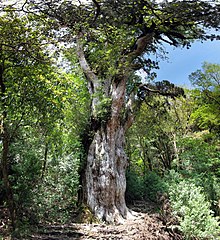Yakushima
| Yakushima | ||
|---|---|---|
| Sempiro waterfall | ||
| Waters | East China Sea | |
| Archipelago | Ōsumi Islands | |
| Geographical location | 30 ° 20 ′ N , 130 ° 31 ′ E | |
|
|
||
| length | 28.3 km | |
| width | 25.7 km | |
| surface | 504.29 km² | |
| Highest elevation |
Miyanoura-dake 1935 m |
|
| Residents | about 12,000 (October 1, 2019) 24 inhabitants / km² |
|
| main place | Yakushima | |
Yakushima ( Japanese 屋 久 島 ) is one of the Ōsumi Islands of the Nansei Islands in Kagoshima Prefecture . The Yakushima community of the same name is located on the island . 42% of the island is designated as Yakushima National Park .
Every year the island is visited by more than 300,000 tourists who are primarily interested in the dense, evergreen wet forest. The unique nature of the island served Hayao Miyazaki as the inspiration for his internationally known animated film Princess Mononoke . Yakushima is connected to the mainland through Yakushima Airport and two ports that are served by ferries.
geography
Yakushima is 61.3 kilometers from the southern tip of Cape Sata (Sata-misaki) on the Ōsumi peninsula of the island of Kyushu . The island has an area of 504.29 km², a circumference of 89 km and a diameter of 28 km. Yakushima was formed around 14 million years ago from granite rock that came to the surface of the sea through seismic activity, a process that is still going on today: the island grows by around one meter every 1000 years. The highest of the approximately 45 peaks on the island is the Miyanoura-dake with 1935 meters. It is also the highest peak in the greater Kyūshū region.
population
Yakushima had the largest population in 1960 with 24,010 people. Until around 1995, the number steadily fell to just over 13,000 and then stayed at this level. The economic structure changed from the export of wood products over several centuries to coastal fishing and oranges to infrastructure measures and tourism as the main source of income.
climate
It is said that it rains "35 days a month" on Yakushima - a quote that goes back to the famous Japanese novel Ukigumo by Fukimo Hayashi . In the lowlands the annual precipitation is 4,000 mm, in the mountains 8,000 mm. In autumn and winter there are also dry periods, but in spring and summer heavy downpours, combined with landslides almost every year. The temperature does not drop below 10 ° C near the sea in winter (water temperature not below 19 ° C), but Yakushima is the southernmost place in Japan where there is snow in the mountains in winter. In summer the temperature reaches its maximum at almost 30 ° C at an altitude of about 1000 m.
UNESCO World Heritage
In 1993, the 107.47 km² large sickle fir forest (cedar forest, Cryptomeria japonica ) of Yakushima was declared a World Heritage Site by UNESCO due to its species-rich flora , especially the Yaku-Sugi - 1,900 very long-lived sickle firs - and impressive rhododendrons (bloom in early June) . The oldest specimen is the Jōmon Sugi , which has existed since the prehistory of Japan, the Jōmon period , with various measurements ranging from an age of 2,170 to 7,200 years. The area was incorporated into the Kirishima-Yaku National Park as early as 1964 and was granted the status of a UNESCO biosphere reserve in the 1980s.
The management of the world natural heritage is shared by the three ministries for the environment, forestry and culture with the prefecture of Kagoshima. A liaison committee aims to facilitate cooperation between the authorities, but the current challenges are still slow to address. Tourism is increasingly leaving its mark on the island, in particular soil erosion and inadequate waste management are causing problems for the delicate balance of nature. The chronically underfunded nature conservation is currently based primarily on voluntary work by the local population, for example with the regular cleaning of the toilets on the heavily frequented hiking trails.
Attractions
- Hiking: Yakushima is a popular hiking island, with more than 30 peaks over 1000 meters.
- Onsen : Bathing in natural hot springs by the sea.
- Beach: public bathing is possible on the beach, at night you can watch sea turtles lay eggs between April and August
- Yaku-Sugi: old, large, thick crescent firs
- Yakumakak (Macaca fuscata yakui), a subspecies of the Japanese macaque or snow monkey, which only occurs in the wild on Yakushima
- numerous waterfalls, e.g. B. Senpiro waterfall , Ōko waterfall , Torōki waterfall
- Anbō Forest Railway
Individual evidence
- ↑ Cary, Beth, 1949-, Schodt, Frederik L., 1950-: Turning point: 1997-2008 . VIZ Media, San Francisco 2014, ISBN 978-1-4215-6090-8 .
- ↑ 島 面積 . (PDF; 136 kB) (No longer available online.) Kokudo Chiriin , October 1, 2015, archived from the original on June 15, 2016 ; Retrieved July 25, 2016 (Japanese).
- ↑ Clive Witham: The Yakushima Guide . Mangrove Press, Poole, UK 2017, ISBN 978-0-9561507-7-6 , pp. 9 .
- ↑ Clive Witham: The Yakushima Guide . Mangrove Press, Poole, UK 2017, ISBN 978-0-9561507-7-6 , pp. 25 .
- ↑ UNESCO World Heritage Center: Yakushima. Retrieved September 6, 2017 .
- ^ Traveling in Japan: Yakushima. In: Japan News No. 25. Japanese Embassy, December 2006, accessed December 22, 2008 .
- ↑ Clive Whitham: The Yakushima Guide . Mangrove Press, Poole, UK 2017, ISBN 978-0-9561507-7-6 , pp. 11-12 .
- ↑ Clive Whitham: The Yakushima Guide . Mangrove Press, Poole, UK 2017, ISBN 978-0-9561507-7-6 , pp. 12 .
Web links
- Entry on the UNESCO World Heritage Center website ( English and French ).
- Yakushima Real Live (Japanese)
- Yakushima Information (Japanese)
- Yakushima Tourist Office (Japanese)




